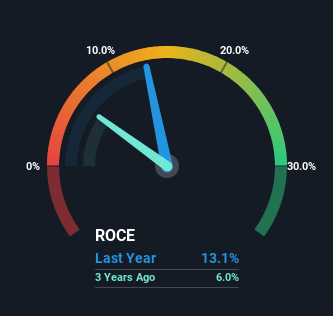- Canada
- /
- Professional Services
- /
- TSX:TRI
Investors Will Want Thomson Reuters' (TSE:TRI) Growth In ROCE To Persist

If we want to find a potential multi-bagger, often there are underlying trends that can provide clues. Firstly, we'd want to identify a growing return on capital employed (ROCE) and then alongside that, an ever-increasing base of capital employed. This shows us that it's a compounding machine, able to continually reinvest its earnings back into the business and generate higher returns. So when we looked at Thomson Reuters (TSE:TRI) and its trend of ROCE, we really liked what we saw.
Understanding Return On Capital Employed (ROCE)
If you haven't worked with ROCE before, it measures the 'return' (pre-tax profit) a company generates from capital employed in its business. The formula for this calculation on Thomson Reuters is:
Return on Capital Employed = Earnings Before Interest and Tax (EBIT) ÷ (Total Assets - Current Liabilities)
0.13 = US$2.0b ÷ (US$19b - US$3.5b) (Based on the trailing twelve months to March 2024).
Thus, Thomson Reuters has an ROCE of 13%. In absolute terms, that's a pretty normal return, and it's somewhat close to the Professional Services industry average of 14%.
See our latest analysis for Thomson Reuters

In the above chart we have measured Thomson Reuters' prior ROCE against its prior performance, but the future is arguably more important. If you're interested, you can view the analysts predictions in our free analyst report for Thomson Reuters .
The Trend Of ROCE
Thomson Reuters has not disappointed with their ROCE growth. The figures show that over the last five years, ROCE has grown 127% whilst employing roughly the same amount of capital. So our take on this is that the business has increased efficiencies to generate these higher returns, all the while not needing to make any additional investments. On that front, things are looking good so it's worth exploring what management has said about growth plans going forward.
What We Can Learn From Thomson Reuters' ROCE
As discussed above, Thomson Reuters appears to be getting more proficient at generating returns since capital employed has remained flat but earnings (before interest and tax) are up. Since the stock has returned a staggering 192% to shareholders over the last five years, it looks like investors are recognizing these changes. In light of that, we think it's worth looking further into this stock because if Thomson Reuters can keep these trends up, it could have a bright future ahead.
Since virtually every company faces some risks, it's worth knowing what they are, and we've spotted 2 warning signs for Thomson Reuters (of which 1 doesn't sit too well with us!) that you should know about.
If you want to search for solid companies with great earnings, check out this free list of companies with good balance sheets and impressive returns on equity.
Valuation is complex, but we're here to simplify it.
Discover if Thomson Reuters might be undervalued or overvalued with our detailed analysis, featuring fair value estimates, potential risks, dividends, insider trades, and its financial condition.
Access Free AnalysisHave feedback on this article? Concerned about the content? Get in touch with us directly. Alternatively, email editorial-team (at) simplywallst.com.
This article by Simply Wall St is general in nature. We provide commentary based on historical data and analyst forecasts only using an unbiased methodology and our articles are not intended to be financial advice. It does not constitute a recommendation to buy or sell any stock, and does not take account of your objectives, or your financial situation. We aim to bring you long-term focused analysis driven by fundamental data. Note that our analysis may not factor in the latest price-sensitive company announcements or qualitative material. Simply Wall St has no position in any stocks mentioned.
Have feedback on this article? Concerned about the content? Get in touch with us directly. Alternatively, email editorial-team@simplywallst.com
About TSX:TRI
Thomson Reuters
Operates as a content and technology company in the Americas, Europe, the Middle East, Africa, and the Asia Pacific.
Flawless balance sheet second-rate dividend payer.
Similar Companies
Market Insights
Community Narratives


